Comptroller Kevin Lembo Archive > News
COMPTROLLER LEMBO REPORTS $300,000 SURPLUS FOR FISCAL YEAR 2015Comptroller Kevin Lembo today, in his first projection for the new fiscal year, said the state is on track to end Fiscal Year 2015 with a $300,000 surplus.
Lembo said he will report the final pre-audited surplus amount for Fiscal Year 2014 on Sept. 30.
In a letter to Gov. Dannel P. Malloy regarding Fiscal Year 2015, Lembo noted that the Office of Policy and Management (OPM) recently disclosed that certain federal reimbursements, including $249.2 million that the state was anticipating this year, have been deferred pending further review of state claims related to part of the Medicaid expansion. Lembo said he expects an update on the status of those funds on Sept. 5.
"I will join with OPM and the State Treasurer in carefully monitoring the federal reimbursement issue and will report on any change in the current situation and the potential budgetary impact," Lembo said.
Lembo reported that General Fund spending is expected to grow by an estimated 2 percent and revenue growth is projected to grow 2.6 percent in Fiscal Year 2015.
"These budget targets will be influenced by changes in economic conditions as the fiscal year progresses," Lembo said. He noted that the miscellaneous tax category contains $75 million related to enhanced collection activities by the Department of Revenue Services. "In future months I will detail changes in existing projections."
In his latest monthly report, Lembo highlighted several economic indicators that will likely influence the state budget going forward, most of them positive - including a sixth consecutive month of job growth in July, a growth in home sales and a strong stock market entering the new fiscal year.
"The jobs are coming back - and the state's economy continues to post moderate monthly growth," Lembo said. "Our next step is focusing on the quality and income tied to those jobs, and closing the widening income gap between the nation's highest and lowest earners."
Lembo pointed to a recent report commissioned by the U.S. Conference of Mayors and The Council on Metro Economies released this month, which noted that the United States has regained 8.7 million jobs lost during the Great Recession, and that employment has surpassed its pre-recession peak of 138.4 million jobs in 2008, according to the report.
However, the report also finds that wages tied to these recovered jobs have declined - and that the highest earners are earning more and the lowest earners are earning less. Income for jobs tied to education and health fields have declined, while the financial services industry income has grown, the report shows (additional details included in the economic summary below).
Lembo highlighted additional new data and other information from federal and state Departments of Labor and other sources that show:

- Year-to-date gains in the employment-driven withholding portion of the state income tax rose 12.3 percent from July of last year.
- The positive withholding trend in July reinforces the pattern established in the second half of Fiscal Year 2014 with an upward withholding trend developing in the second half of the fiscal year. It should be noted that July withholding revenue is accrued to Fiscal Year 2014 for purposes of GAAP-based budgetary reporting.
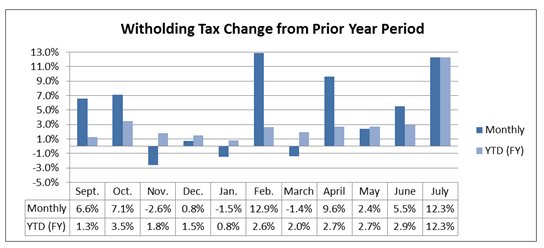
- Taking a longer view, in the four years leading up to the last recession, the annual increase in income tax withholdings averaged 6.9 percent. In Fiscal Year 2011 and 2012, the withholding receipts spiked due to an increase in the income tax rates. Over the past six-month period, withholding receipts are up at an average monthly rate of 4.2 percent.
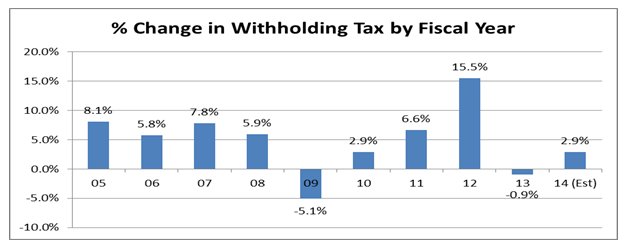
- Connecticut gained 2,400 payroll jobs in July. This is the sixth consecutive month of employment growth in the state, reversing an earlier trend of highly erratic monthly gains and losses.
- The strongest monthly gain in July was in manufacturing employment, up by 1,000 positions over last month.
- According to the Department of Labor, Connecticut has regained 76,400 payroll positions, or 64.1 percent of the 119,100 positions lost to the March 2008 - February 2010 employment recession. The state has regained 76.9 percent of the private sector jobs lost during the recession.
- Nationally, all recessionary job losses have been regained and exceeded. During the latest 12-month period Connecticut employment was advancing at a 0.6-percent rate; national employment was advancing at a rate of 1.9 percent.
- The table below shows the distribution of employment gains and losses by major employment sector over the latest 12-month period ending in June.
- Job additions in Connecticut during this period total 9,200.
| Job Gains Latest 12 Months | Job Losses Latest 12 Months | ||
|---|---|---|---|
| Sector | Sector | ||
| Education & Health | 5,200 | Government | -8,100 |
| Transp. & Public Utility | 4,900 | Financial Activities | -1,200 |
| Leisure & Hospitality | 4,800 | Information | -900 |
| Construction | 2,700 | Manufacturing | -600 |
| Prof & Business Service | 1,800 | ||
| Other Services | 600 |
- Connecticut's unemployment rate fell to 6.6% in July; the national unemployment rate was 6.2%. Connecticut's unemployment rate has continued to decline from a high of 9.5% in October 2010.
- There are approximately 122,900 unemployed workers in Connecticut. A low of 36,500 unemployed workers was recorded in October of 2000.
- Connecticut's labor force has been growing since the beginning of the year. Throughout the post-recession period, Connecticut's labor force participation rate has been above the national average.
![]()
- The Department of Labor calculates that Connecticut's average hourly earnings rose a modest 0.7% over July of 2013. Average private weekly pay rose at the same rate to a level of $940.99.
- Average hourly earnings of private sector workers have struggled to establish a consistent growth trend over the last two years.
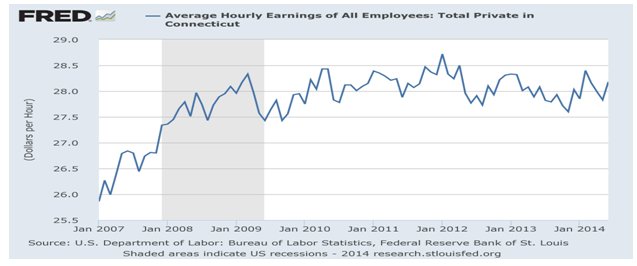
- Connecticut is not alone in experiencing sluggish wage growth. A recent report issued by the United States Conference of Mayors found that jobs added after the recession on average pay 23 percent less than the jobs lost during the recession.
- At the same time, the nation's high-income workers have accumulated wealth at a faster rate than middle- to low-income workers. From 2005 to 2012, the top 20 percent of earners were responsible for more than 60 percent of all income gains in the country according to the report. By contrast, the bottom 40 percent saw only 6.6 percent of the increases.
- These patterns are seen in Connecticut specific data as well. A persistent problem has been that wages in the lower paying job sectors are adding employees, while higher paying sectors are shedding jobs.
- The point is illustrated by looking at wage changes in the job-gaining education and health services sector as contrasted with the wage trend in the job-shedding financial activities sector. You will also note the higher overall wage level in financial activities as opposed to education and health services in Connecticut.
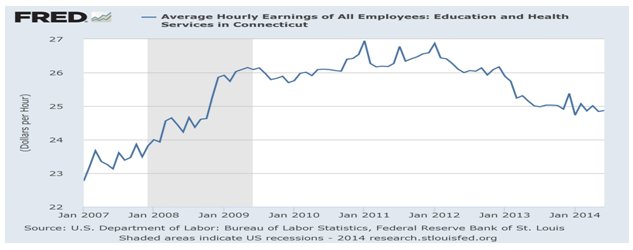

- The year-to-year change in the Consumer Price Index for All Urban Consumers (CPI-U, U.S. City Average, not seasonally adjusted did not grow in July).
- Based on data released by the Bureau of Economic Analysis on June 24, personal income in Connecticut grew at an annualized rate of 3.7 percent in the 1st quarter of 2014. This ranked Connecticut 16th in quarterly personal income growth. State personal income grew at a rate of 2.1 percent between 2012 and 2013, ranking Connecticut 37th nationally in personal income growth.
- The chart below shows the annual trend in Connecticut personal income over
time. The 2014 estimate is based on annualizing first-quarter results. The
results for the 2nd quarter will be available on September 30.


-
Real estate conveyance tax receipts continued to advance at a double-digit rate in July as compared to July of last year.
-
According to a report from the Warren Group released on August 5, single-family home sales in Connecticut fell 4.9 percent in the 2nd quarter of 2014 as compared to the same quarter a year ago. However, June marked a strong month of sales growth in the state with a gain of 5.8 percent over May sales. After a fall and winter of notable sales declines, the spring and early summer posted improvement in the housing market.
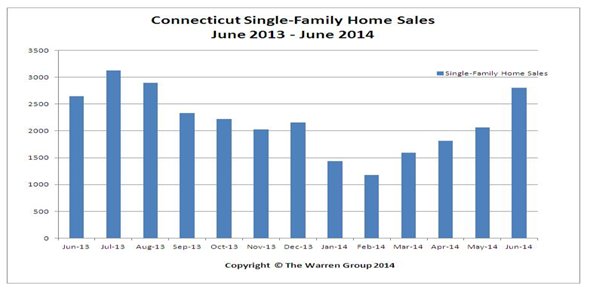
- Year-over-year home prices fell 3.2 percent in June. The median sales price of a single-family home statewide decreased to $276,000 in June, down from $285,000 in June 2013.
- Connecticut condominium sales posted a double-digit gain in June, rising almost 14.1 percent from a year earlier. A total of 760 condos sold in June, compared with 666 a year earlier. The median selling price for condos in June was $180,000, up 2.9 percent from $175,000 a year earlier.
- The National Association of Realtors reported a national sales trend similar to Connecticut. Existing home sales in July were down 4.3 percent from the same month last year, but sales were up 2.4 percent in July from the prior month. Price gains nationally exceed Connecticut's pace. The median existing-home price for all housing types in July was $222,900, which is 4.9 percent above July 2013. This marks the 29th consecutive month of year-over-year price gains.
- Conventional mortgage rates hit a low of 3.4 percent in January 2013. Rates in June 2014 were 4.2 percent.
![]()
- Estimated payments in the final quarter of Fiscal Year 2014 were advancing at a rate of just over 9 percent. September receipts will be the first significant deposit of quarterly estimated payments in Fiscal Year 2015.
DOW
- At this writing the Dow Jones Industrial Average has posted a 12-month gain of
14.5 percent; however, on a calendar-year-to-date basis the market has been less
robust.
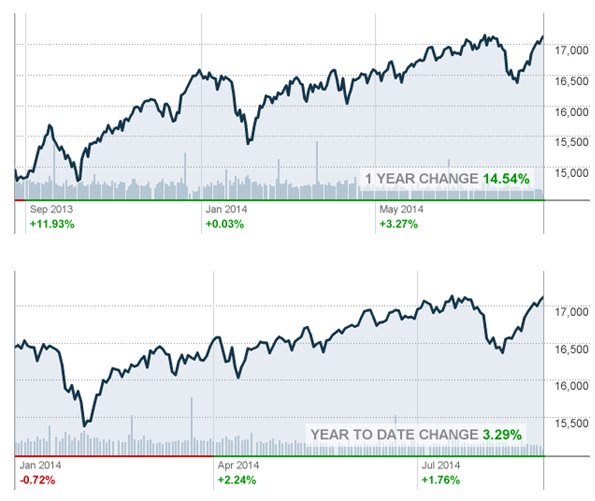
Consumers
- July advance retail sales were up 3.7 percent from the same month last year. This is slightly below the 4.2-percent pace set for the quarter.
- Automobile dealers, health and personal care establishments and non-store retailers posted the strongest July gains. No businesses saw double-digit gains in July as had occurred in past periods.
- According to the Federal Reserve, consumer credit in June was below levels attained earlier in the year. June credit grew at a rate of 6.5 percent. Consumer credit in the 2nd quarter of 2014 grew at rate of almost 8 percent. Credit card related debt expanded just 1.3 percent in June, while longer term loans grew 8.4 percent.
Business and Economic Growth
- Based on the July 30 release by the Bureau of Economic Analysis, real GDP increased at a rate of 4.0 percent in the 2nd quarter of 2014. In the 1st quarter of 2014 real GDP declined 2.1 percent.
- The negative GDP reflects decreases in private inventory investment, exports, state and local government spending, and both residential and non-residential investment. Partially offsetting these declines were an increase in personal consumption expenditures. Imports, which reduce GDP, also increased
- In the 1st quarter of 2014, U.S. corporate profits posted a decline of 4.8 percent from the same quarter one year ago. Profits grew by better than 7 percent in both 2011 and 2012.
- The Department of Labor's General Drift Indicators are composite measures of the four-quarter change in three coincident (Connecticut Manufacturing Production Index, nonfarm employment, and real personal income) and four leading (housing permits, manufacturing average weekly hours, Hartford help-wanted advertising, and initial unemployment claims) economic variables, and are indexed so 1986 = 100.
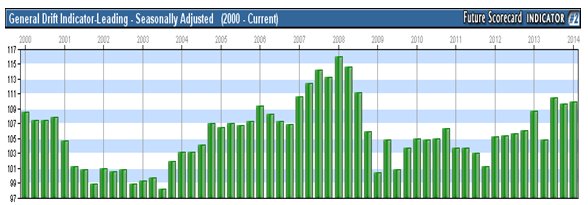
***END***
